I transcribe the recent interview at Omenka, the arts magazine. It is now available online at http://www.omenkaonline.com/jess-castelotte-on-collecting-nigerian-art/.
JESS CASTELLOTE ON
COLLECTING NIGERIAN ART
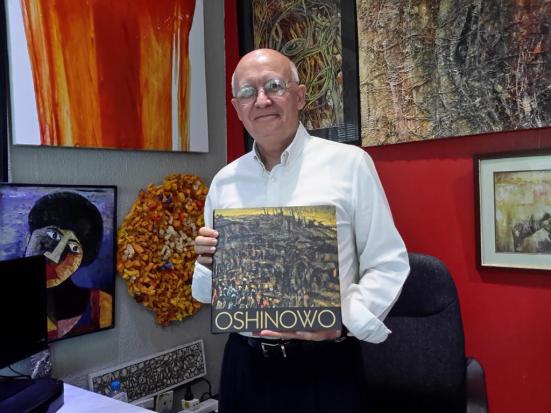
December 23, 2016
Lagos-based Spanish architect Jess Castellote started out in Nigeria as a project manager as early as 1984. He has since then combined his professional work with an intense involvement in the Nigerian art scene, also organizing significant exhibitions including Without Borders, a group show featuring leading contemporary artists Kainebi Osahenye, Wole Lagunju, Ben Osaghae and Rom Isichei (2004).
Castellote has also maintained a widely accessed blog on contemporary art in Nigeria since 2008, “A View from My Corner”, written two books; Contemporary Nigerian Art in Lagos Private Collection: New Trees in an Old Forest and Oshinowo, as well as published several papers focused on developing the Nigerian art scene. He has also acted as an independent art advisor to several private and corporate bodies. He is presently the Director of the Virtual Museum of Modern Nigerian Art, an online educational resource he initiated at the Pan-African University, Lagos. In this interview with Omenka magazine, he provides more insight on his role as an art collector and critic.
You are a Spanish-born architect who relocated to Lagos in 1994. Was your coming to Lagos and getting involved in the growing art scene in Lagos by chance or an accident?
In my school and university years in Spain, I was very fortunate to grow in an environment where the humanities were given great attention. My interest in the arts started early and my architectural studies reinforced this interest. Naturally, when I came to Nigeria, I tried to learn about the artistic expressions of the country. Initially, my attention was directed to traditional art forms, but soon I focused on contemporary art. For the past twenty years I have been in regular contact with Nigerian artists, collectors, gallerists and scholars. More recently, I have tried to expand my attention to other areas of the continent.

Accra. Ghana. August 2016. In the background, artwork by the Ghanaian artist Elolo Bosoka
What prompted your interest in collecting art, and how would you describe the typical Nigerian collector?
For years, scholars have been pointing out that art is a social product, a collective enterprise. Artists and their works, are not enough to create and sustain an art world. There is need for a great variety of mediators, interpreters and consumers. Without historians, dealers, curators, collectors and cultural agents, artists would be left in a vacuum and their works would remain in their studios. My interest in the visual arts goes beyond the works of art. I try to follow the artists, but also the institutions that introduce them into the art world: the galleries, dealers, auction houses and art fairs that make them visible to the rest of us; whether as spectators or as collectors, in the art world, we are all consumers and beneficiaries of their works. I think it is possible to enjoy thoroughly what the visual arts have to offer, without owning the artworks. I have known collectors who enjoyed the fact of owning art, while I have also come in contact with person who enjoyed artworks regularly without actually owning them. That is one of the reasons why, for years, I have devoted a great deal of time to visiting studios, exhibitions, galleries, art events and collectors. The experience is worthwhile. In any active art world there are many interesting persons from whom to learn. This interaction with people has been in many cases even more rewarding than the experience of the artworks themselves.
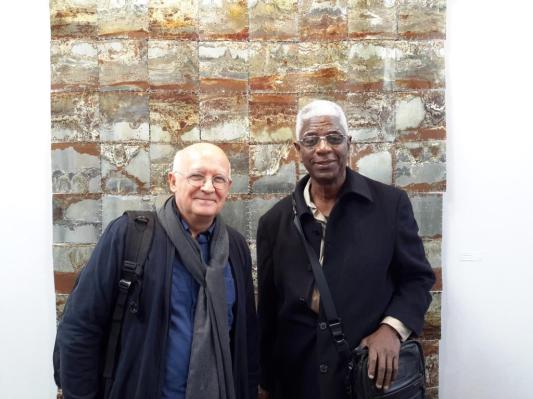
With El Anatsui at AKAA art fair, Paris. November 2016
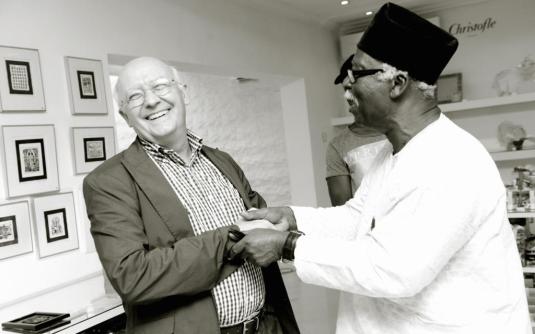
Lagos, 2013. With Bruce Onobrakpeya
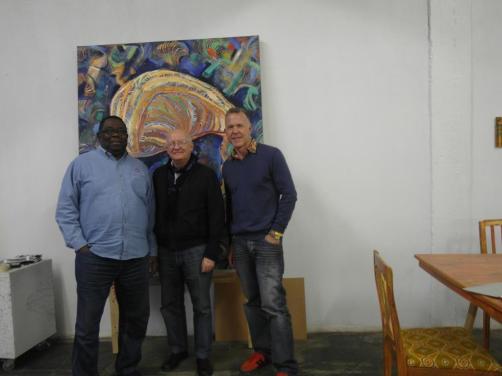
With Sammy Olagbaju and artist Gary Stephens at his studio in Johannesburg, 2014
Collecting as a social practice is a relatively recent phenomenon in Nigeria. The late Sammy Olagbaju, with his usual wit and good humour, used to refer to the collectors as a “tribe”. They share a common passion for the gathering of art, but the reasons why they collect, the way they go about assembling their collections, the proportion of their resources they are ready to devote to the acquisitions of works, is as varied as in any other art world. Some collectors buy art because they want to enjoy the artworks, some do it because they see art collecting as social practice that allows them reinforce or improve their social status, some do it with an eye on the price and as a way of diversifying their investments, and others do it for a mixture of all of these reasons.
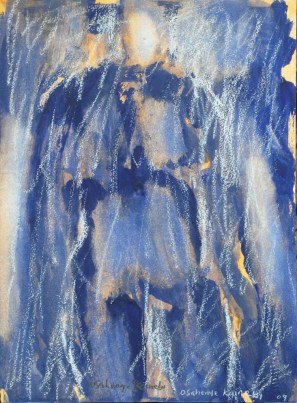
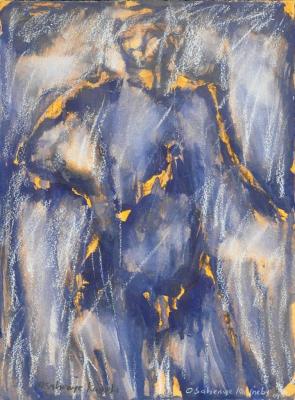 Kainebi Osahenye
Kainebi Osahenye
How would you describe your collecting habits and the thrust of your collection?
I am not a collector, but, over the years, my regular contact with artists, especially young ones, has allowed me acquire a few pieces. I have never had, and I will most likely never have a work by Enwonwu, Okeke, Grillo, or any of the most prominent artists in the Nigerian art canon. Instead, I have collected from younger artists, mostly not very well known when I met them: Tony Nsofor, Uche Peters, Gerald Chukwuma, George Edozie, Olumide Onadipe, Busayo Lawal, Raji Mohamed and many others. Some of these pieces are now in the art collection of the Pan-Atlantic University. It gives me a great joy when people, and especially students, see and enjoy them there. I think the best way of collecting is the one done with the ultimate aim of making these wonderful artworks available to the general public. For years, several of us have been considering the possibility of setting up an art museum that would allow many people, and especially young students, learn about the history of Nigerian art as well as see physically some significant works. Thanks to the foresight of Pan-Atlantic University and the generosity of Yemisi Shyllon, the first phase of an art museum is already being built at the main campus of the university. It will still take some time before the museum opens, but I am sure, once it does, it will be a great contribution to the Nigerian cultural world. I am glad to be part of this project.
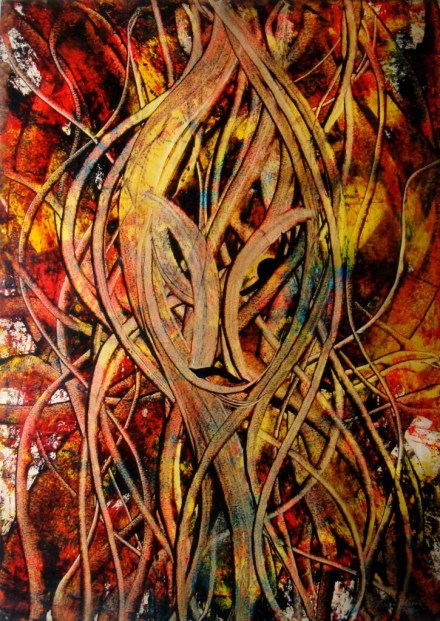
Busayo Lawal
Your blog, A View From My Corner is a reference point on contemporary art in Nigeria. You have also written several scholarly articles and books on Nigerian artists. How important have these interventions been?
Following Howard Becker and other sociologists of art, I see the production and distribution of art as an activity not totally different from other forms of work. Artists can render a service to society through their work. The idea of the artist as a “creative genius”, only responsible to his or her own inspiration, perhaps needs to be balanced by a vision of the artist as a “worker” who, though his or her artistic production, contributes to make a better and more humane society. Art as service is an idea that deserves more attention. I also hope my contribution is a small service to the society. William Blake said “He who would do good to another must do it in Minute Particulars: general Good is the plea of the scoundrel, hypocrite, and flatterer, for Art and Science cannot exist but in minutely organized Particulars.” I like this expression: “minute particulars.” I am not in a position and I do not have the capacity or the ambition to have a big influence on Nigerian art, but I hope my small contribution, my “minute particulars” become useful. A couple of books or a few articles in academic journals are not going to change the course of Nigerian art, but the accumulation of efforts from diverse perspectives can do that.
 Tony Nsofor, 2016, Untitled, mixed media on paper
Tony Nsofor, 2016, Untitled, mixed media on paper
Alongside Tayo Fagbule, you wrote an incisive report on the Nigerian art market. What major trends can you infer, and how can you compare these to other parts of Africa, and indeed the international market for African art?
Working with Tayo on the research and publication of the 2014 and 2015 Nigerian Art Market Report allowed us to learn a lot about the art market, an indispensable component of the art world. Unfortunately, the academic and institutional elements of the Nigerian art world are not as strong as they should ideally be and this situation has created, in my opinion an imbalance that is not healthy for the Nigerian art ecosystem. The “market” (art buyers and art sellers) has a tremendous power in the Nigerian art world. The situation is not the same across Africa. For instance, in Senegal, institutional support for the arts clearly surpasses the influence of the market and collectors. In other African countries, contemporary art production is so closely linked to the production of crafts and decorative objects that local artworlds are barely existent. Fortunately, there is great vitality on the continent and numerous focuses of relevant artistic activity have sprung up in recent years. Early in the year, I was fortunate to see first-hand the Kenyan artworld growing far beyond the production of trite and corny products for the tourist market. My meetings with artists, gallerists and cultural agents helped me experience what was for me, an unexpected dynamic art environment. A couple of months ago, I had a similar experience in Accra. Just a few days ago, I visited the AKAA art fair for contemporary African art in Paris and I could see the rising number of artists from the continent and the diaspora who are already part of global art discourses. Lagos Photo Festival and ArtX are two good examples of the growing internationalization of the Nigerian art scene. Their influence goes beyond Nigeria.
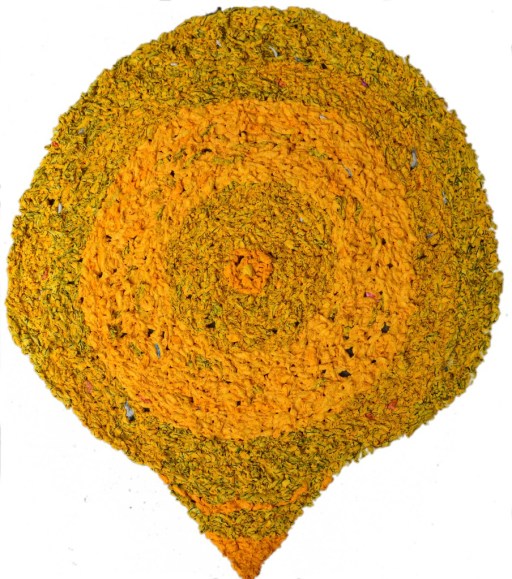
Olumide Onadipe, One is all, 2014 melted polythene
Please tell us more about your forthcoming projects on developing art in Nigeria.
Almost thirty years after I finished my studies; I am embarking now on a major project to strengthen my understanding and my competence in this field. Last year, I completed a Masters degree in Art History and I am working already towards a doctorate. Now, when somebody asks me about what I do, I tell them that I used to be an architect and project manager, but I have become a student. And a happy student, for that matter… Having to read, study and articulate ideas in a clear and coherent way, is forcing me to rethink some of my preconceptions and beliefs. As it happens in all fields, the effort of going deeper brings to me the reward of the discovery of new things, new perspectives, practices and theories necessary. I am thoroughly enjoying being a student. I believe documentation and basic information necessary are crucial at this stage in the development of the visual arts in the country. For this reason, a couple of years ago, Yinka Fisher and I started a foundation whose primary focus is the documentation of Nigerian art: the Foundation for Contemporary and Modern Visual Arts (FCMVA). In addition to video documentaries, recently, we have published a large book on the works of Kolade Oshinowo. It is already in the bookshops. I am working now on two other book projects: a Manual for Collectors and a monograph on a well-known, though younger artist. It is clear to me that Nigerian art needs many more people looking at it and promoting, documenting and curating it from different perspectives and for different audiences. Art is a tremendously rich and complex reality that has great things to offer for everybody. I am a very fortunate person, to be part of this growing Nigerian art world.
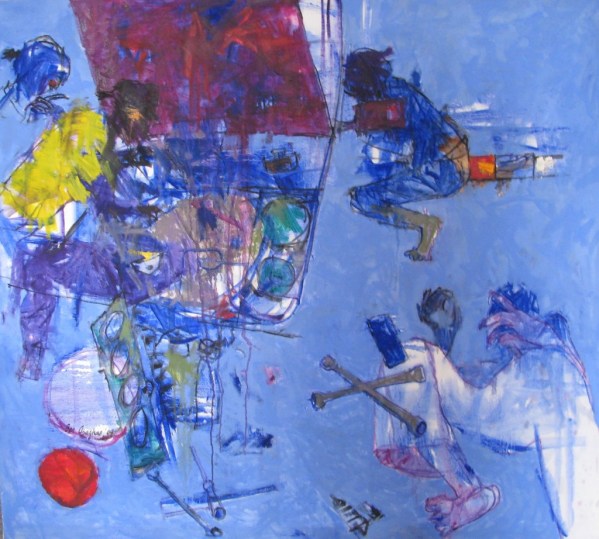
Ben Osaghae




 Kainebi Osahenye
Kainebi Osahenye



 Tony Nsofor, 2016, Untitled, mixed media on paper
Tony Nsofor, 2016, Untitled, mixed media on paper
